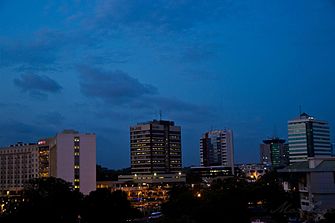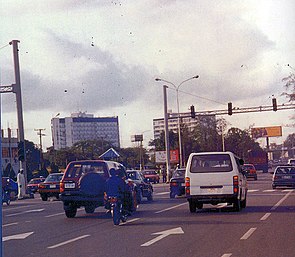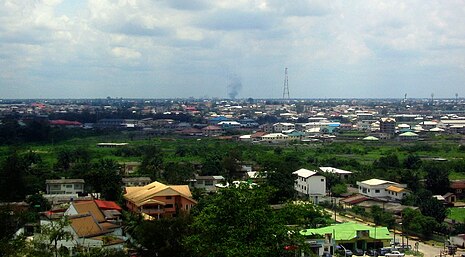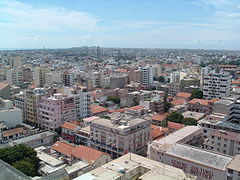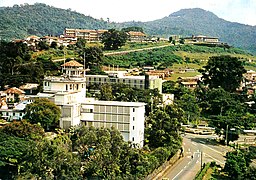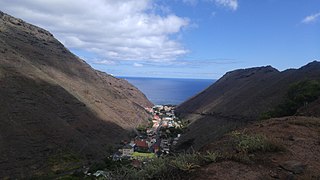West Africa
| West Africa | |
|---|---|
 Western Africa (UN subregion) | |
| Area | 5,112,903 km2 (1,974,103 sq mi) (7th) |
| Population | 418,544,337 (2021 est.) (3rd)[1][2] 381,981,000 (female: 189,672,000; male: 192,309,000 (2017 est.[3]) |
| Density | 49.2/km2 (127.5/sq mi) |
| Demonym | West African |
| Countries | Sovereign states (16) |
| Dependencies | |
| Time zones | UTC−1 to UTC+1 |
| Major Regional Organizations | Economic Community of West African States (ECOWAS; established 1975) |
| Total GDP (PPP) | US$2.091 trillion (2022) (23rd)[4] |
| GDP (PPP) per capita | $2,500 (2013)[5] |
| Total GDP (nominal) | $810 billion (2023)[6][7] |
| Total GDP (nominal) per capita | $1,937 (2023)[6] |
| Currency | List |
| Largest cities | List |
| UN M.49 code | 011 – West Africa202 – Sub-Saharan Africa002 – Africa001 – World |
West Africa, or Western Africa, is the westernmost region of Africa. The United Nations defines Western Africa as the 16 countries of Benin, Burkina Faso, Cape Verde, The Gambia, Ghana, Guinea, Guinea-Bissau, Ivory Coast, Liberia, Mali, Mauritania, Niger, Nigeria, Senegal, Sierra Leone, and Togo, as well as Saint Helena, Ascension and Tristan da Cunha (United Kingdom Overseas Territory).[8][9] The population of West Africa is estimated at 419 million[1][2] people as of 2021, and at 381,981,000 as of 2017, of which 189,672,000 were female and 192,309,000 male.[3] The region is demographically[10] and economically[11] one of the fastest growing on the African continent.
Early history in West Africa included a number of prominent regional powers that dominated different parts of both the coastal and internal trade networks, such as the Mali and Gao Empires. West Africa sat at the intersection of trade routes between Arab-dominated North Africa and further south on the continent, the source of specialized goods such as gold, advanced iron-working, and ivory. After European exploration encountered rich local economies and kingdoms, the Atlantic slave trade built on already existing slave systems to provide labor for colonies in the Americas. After the end of the slave trade in the early 19th century, European nations, especially France and Britain, continued to exploit the region through colonial relationships. For example, they continued exporting a number of extractive goods, including labor-intensive agricultural crops like cocoa and coffee, forestry products like tropical timber, and mineral resources like gold. Since independence, many West African countries, like Ivory Coast, Ghana, Nigeria and Senegal, have played important roles in the regional and global economies.
West Africa has a rich ecology, with strong biodiversity and several distinct regions. The area's climate and ecology are heavily influenced by the dry Sahara to the north and east, which provides dry winds during the Harmattan, as well as the Atlantic Ocean to the south and west, which provides seasonal monsoons. This mixture of climates gives West Africa a rich array of biomes, from biodiversity-rich tropical forests to drylands supporting rare and endangered fauna such as pangolins, rhinoceros, and elephants. Because of the pressure for economic development, many of these ecologies are threatened by processes like deforestation, biodiversity loss, overfishing, pollution from mining, plastics and other industries, and extreme changes resulting from climate change in West Africa.
History
[edit]The history of West Africa can be divided into five major periods: first, its prehistory, in which the first human settlers arrived, developed agriculture, and made contact with peoples to the north; the second, the Iron Age empires that consolidated both intra-Africa, and extra-Africa trade, and developed centralized states; third, major polities flourished, which would undergo an extensive history of contact with non-Africans; fourth, the colonial period, in which Great Britain and France controlled nearly the entire region; and fifth, the post-independence era, in which the current nations were formed.
Prehistory
[edit]
West African populations were considerably mobile and interacted with one another throughout the population history of West Africa.[12] Acheulean tool-using archaic humans may have dwelled throughout West Africa since at least between 780,000 BP and 126,000 BP (Middle Pleistocene).[13] During the Pleistocene, Middle Stone Age peoples (e.g., Iwo Eleru people,[14] possibly Aterians), who dwelled throughout West Africa between MIS 4 and MIS 2,[15] were gradually replaced by incoming Late Stone Age peoples, who migrated into West Africa[16] as an increase in humid conditions resulted in the subsequent expansion of the West African forest.[17] West African hunter-gatherers occupied western Central Africa (e.g., Shum Laka) earlier than 32,000 BP,[14] dwelled throughout coastal West Africa by 12,000 BP,[18] and migrated northward between 12,000 BP and 8000 BP as far as Mali, Burkina Faso,[18] and Mauritania.[19]

During the Holocene, Niger-Congo speakers independently created pottery in Ounjougou, Mali[21][22][23] – the earliest pottery in Africa[24] – by at least 9400 BCE,[21] and along with their pottery,[24] as well as wielding independently invented bows and arrows,[25][26] migrated into the Central Sahara,[24] which became their primary region of residence by 10,000 BP.[25] The emergence and expansion of ceramics in the Sahara may be linked with the origin of Round Head and Kel Essuf rock art, which occupy rockshelters in the same regions (e.g., Djado, Acacus, Tadrart).[27] Hunters in the Central Sahara farmed, stored, and cooked undomesticated central Saharan flora,[28] underwent domestication of antelope,[29] and domesticated and shepherded Barbary sheep.[28] After the Kel Essuf Period and Round Head Period of the Central Sahara, the Pastoral Period followed.[30] Some of the hunter-gatherers who created the Round Head rock art may have adopted pastoral culture, and others may have not.[31] As a result of increasing aridification of the Green Sahara, Central Saharan hunter-gatherers and cattle herders may have used seasonal waterways as the migratory route taken to the Niger River and Chad Basin of West Africa.[32] In 2000 BCE, "Thiaroye Woman",[33] also known as the "Venus of Thiaroye",[34][33] may have been the earliest statuette created in Sub-Saharan West Africa; it may have particularly been a fertility statuette, created in the region of Senegambia,[34] and may be associated with the emergence of complexly organized pastoral societies in West Africa between 4000 BCE and 1000 BCE.[35] Though possibly developed as early as 5000 BCE,[36] Nsibidi may have also developed in 2000 BCE,[37][36] as evidenced by depictions of the West African script on Ikom monoliths at Ikom, in Nigeria.[36] Migration of Saharan peoples south of the Sahelian region resulted in seasonal interaction with and gradual absorption of West African hunter-gatherers, who primarily dwelt in the savannas and forests of West Africa.[18] In West Africa, which may have been a major regional cradle in Africa for the domestication of crops and animals,[38][39] Niger-Congo speakers domesticated the helmeted guineafowl[40] between 5500 BP and 1300 BP;[38] domestication of field crops occurred throughout various locations in West Africa, such as yams (d. praehensilis) in the Niger River basin between eastern Ghana and western Nigeria (northern Benin), rice (oryza glaberrima) in the Inner Niger Delta region of Mali, pearl millet (cenchrus americanus) in northern Mali and Mauritania, and cowpeas in northern Ghana.[39] After having persisted as late as 1000 BP,[18] or some period of time after 1500 CE,[41] remaining West African hunter-gatherers, many of whom dwelt in the forest-savanna region, were ultimately acculturated and admixed into the larger groups of West African agriculturalists, akin to the migratory Bantu-speaking agriculturalists and their encounters with Central African hunter-gatherers.[18]

Empires
[edit]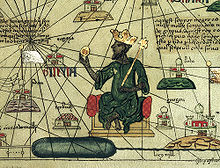
The development of the region's economy allowed more centralized states and civilizations to form, beginning with Dhar Tichitt that began in 1600 B.C. followed by Djenné-Djenno beginning in 300 B.C. This was then succeeded by the Ghana Empire that first flourished roughly between the 2nd and 12th centuries C.E., which later gave way to the Mali Empire. In current-day Mauritania, there exist archaeological sites in the towns of Tichit and Oualata that were initially constructed around 2000 B.C., and were found to have originated from the Soninke branch of the Mandé peoples. Also, based on the archaeology of the city of Kumbi Saleh in modern-day Mauritania, the Mali empire came to dominate much of the region until its defeat by Almoravid invaders in 1052.
Three great kingdoms were identified in Bilad al-Sudan by the ninth century. They included Ghana, Gao and Kanem.[42]
The Sosso Empire sought to fill the void but was defeated (c. 1240) by the Mandinka forces of Sundiata Keita, founder of the new Mali Empire. The Mali Empire continued to flourish for several centuries, most particularly under Sundiata's grandnephew Musa I, before a succession of weak rulers led to its collapse under Mossi, Tuareg and Songhai invaders. In the 15th century, the Songhai would form a new dominant state based on Gao, in the Songhai Empire, under the leadership of Sonni Ali and Askia Mohammed.

Meanwhile, south of the Sudan, strong city-states arose in Igboland, such as the 10th-century Kingdom of Nri, which helped birth the arts and customs of the Igbo people, Bono State in the 11th century, which gave birth to the numerous Akan States, while Ife rose to prominence around the 12th century. Further east, Oyo arose as the dominant Yoruba state and the Aro Confederacy as a dominant Igbo state in modern-day Nigeria.
The Kingdom of Nri was a West African medieval state in present-day southeastern Nigeria and a subgroup of the Igbo people. The Kingdom of Nri was unusual in the history of world government in that its leader exercised no military power over his subjects. The kingdom existed as a sphere of religious and political influence over a third of Igboland and was administered by a priest-king called as an Eze Nri. The Eze Nri managed trade and diplomacy on behalf of the Nri people and possessed divine authority in religious matters.
The Oyo Empire was a Yoruba empire of what is today Western, North central Nigeria and southern Republic of Benin. Established in the 14th century, the Oyo Empire grew to become one of the largest West African states. It rose through the outstanding organizational skills of the Yoruba, wealth gained from trade and its powerful cavalry. The Oyo Empire was the most politically important state in the region from the mid-17th to the late 18th century, holding sway not only over most of the other kingdoms in Yorubaland, but also over nearby African states, notably the Fon Kingdom of Dahomey in the modern Republic of Benin to the west.
The Benin Empire was a post-classical empire located in what is now southern Nigeria. Its capital was Edo, now known as Benin City, Edo. It should not be confused with the modern-day country called Benin, formerly called Dahomey. The Benin Empire was "one of the oldest and most highly developed states in the coastal hinterland of West Africa, dating perhaps to the eleventh century CE",. The Benin Empire was governed by a sovereign Emperor with hundreds of thousands of soldiers and a powerful council rich in resources, wealth, ancient science and technology with cities described as beautiful and large as Haarlem. "Olfert Dapper, a Dutch writer, describing Benin in his book Description of Africa (1668) ". Its craft was the most adored and treasured bronze casting in the history of Africa. It was annexed by the British Empire in 1897 during the invasion and scramble of Africa.
European contact and enslavement
[edit]
Portuguese traders began establishing settlements along the coast in 1445, followed by the French, English, Spanish, Danish and Dutch; the African slave trade began not long after, which over the following centuries would debilitate the region's economy and population.[43] The slave trade also encouraged the formation of states such as the Bono State, Bambara Empire and Dahomey, whose economic activities include but not limited to exchanging slaves for European firearms.[44]
Colonialism
[edit]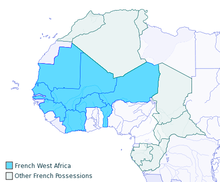
In the early 19th century, a series of Fulani reformist jihads swept across Western Africa. The most notable include Usman dan Fodio's Fulani Empire, which replaced the Hausa city-states, Seku Amadu's Massina Empire, which defeated the Bambara, and El Hadj Umar Tall's Toucouleur Empire, which briefly conquered much of modern-day Mali.
However, the French and British continued to advance in the Scramble for Africa, subjugating kingdom after kingdom. With the fall of Samory Ture's new-founded Wassoulou Empire in 1898 and the Ashanti queen Yaa Asantewaa in 1902, most West African military resistance to colonial rule resulted in failure.
Part of the West-African regions underwent an increase in the numeracy level throughout the 19th century. The reason for such a growth was predetermined by a number of factors. Namely, the peanut production and trade, which was boosted by the demand of the colonial states. Importantly, the rise of the numeracy was higher in the regions which were less hierarchical and had less dependent from the slavery trade (e.g. Sine and Salum). Whereas areas with the opposite trends illustrated opposite tendencies (e.g. central and northern Senegal). Those patterns were further even more stimulated with the French colonial campaign.[45]
Britain controlled the Gambia, Sierra Leone, Ghana, and Nigeria throughout the colonial era, while France unified Senegal, Guinea, Mali, Burkina Faso, Benin, Ivory Coast, and Niger into French West Africa. Portugal founded the colony of Guinea-Bissau, while Germany claimed Togoland, but was forced to divide it between France and Britain following First World War due to the Treaty of Versailles. Only Liberia retained its independence, at the price of major territorial concessions.
Postcolonial era
[edit]Following World War II, nationalist movements arose across West Africa. In 1957, Ghana, under Kwame Nkrumah, became the first West African colony to achieve its independence, followed the next year by France's colonies (Guinea in 1958 under the leadership of President Ahmed Sekou Touré); by 1974, West Africa's nations were entirely autonomous.
Since independence, many West African nations have been submerged under political instability, with notable civil wars in Nigeria, Sierra Leone, Liberia, and Ivory Coast, and a succession of military coups in Ghana and Burkina Faso.
Since the end of colonialism, the region has been the stage for some brutal conflicts, including:
- Nigerian Civil War
- First Liberian Civil War
- Second Liberian Civil War
- Guinea-Bissau Civil War
- Ivorian Civil War
- Sierra Leone Rebel War
- Mali War
Geopolitical division
[edit]
| * Benin * Burkina Faso * Cape Verde * Ivory Coast * The Gambia | * Ghana * Guinea * Guinea-Bissau * Liberia * Mali | * Niger * Nigeria * Senegal * Sierra Leone * Togo |
Geopolitically, the United Nations definition of subregion Western Africa includes the preceding states with the addition of Mauritania (which withdrew from ECOWAS in 1999), comprising an area of approximately 6.1 million square km.[46] The UN region also includes the United Kingdom Overseas Territory of Saint Helena, Ascension and Tristan da Cunha in the south Atlantic Ocean.[8]
Area
[edit]In the United Nations scheme of African regions, the region of Western Africa includes 16 states and the United Kingdom Overseas Territory of Saint Helena, Ascension and Tristan da Cunha:[8] Mali, Burkina Faso, Senegal and the Niger are mostly in the Sahel, a transition zone between the Sahara desert and the Sudanian Savanna; Benin, Ivory Coast, The Gambia, Ghana, Guinea, Guinea-Bissau, Liberia, Sierra Leone, Togo and Nigeria compose most of Guinea, the traditional name for the area near the Gulf of Guinea; Mauritania lies in the Maghreb, the northwestern region of Africa that has historically been inhabited by West African groups such as the Fulani, Soninke, Wolof, Serer and Toucouleur people,[47] along with Arab-Berber Maghrebi people such as the Tuareg; Cape Verde is an island country in the Atlantic Ocean; and Saint Helena, Ascension and Tristan da Cunha consists of eight main islands located in four different parts of the Atlantic. Due to Mauritania's increasingly close ties to the Arab World and its 1999 withdrawal from the Economic Community of West African States (ECOWAS), in modern times it is often considered, especially in Africa, as now part of western North Africa.[48][49][50][51][52][53]
List of countries
[edit] Benin
Benin Burkina Faso
Burkina Faso Cape Verde
Cape Verde Ivory Coast
Ivory Coast The Gambia
The Gambia Ghana
Ghana Guinea
Guinea Guinea-Bissau
Guinea-Bissau Liberia
Liberia Mali
Mali Niger
Niger Nigeria
Nigeria Senegal
Senegal Sierra Leone
Sierra Leone Togo
Togo United Kingdom
United Kingdom
Cities
[edit]Major and principal cities in West Africa include, geographically eastward:
|
|
Environment
[edit]Nature
[edit]

Before European colonisation, West African countries such as those from the Senegambia region (Senegal and the Gambia) used to have a diverse wildlife including lions, hippopotamus, elephants, antelopes, leopards etc.[54] However, during colonization, the European colonizers such as the French and British killed most of the wildlife particularly the lions, using their body parts as trophies. By the turn of the 20th century, the Senegambia region had lost most of its lion population and other exotic animals due to poaching. By the 1930s, the Gambian elephant population became extinct. That phenomenon was not only limited to the Senegambia region but affected much of West Africa as the region lost much of its "natural resources once tied so closely to its cultural identity. Poaching has stolen most of its wildlife." The British issued poaching licenses, and although they would later try to reverse the damage that had been done by attempting to preserve what was left of the local wildlife, but by that time, it was too late.[55][56] During the 1930s, the elephant population in the Gold Coast was about 300, and Sierra Leone between 500 and 600. Although a small number of elephants survived in Nigeria, hunting, agricultural expansion and clearing of forest in that country drastically affected its wildlife population, particularly elephants.[56]
Despite the historical damage that has been done to the region's wildlife populations, there are still some protected nature reserves within the region. Some of these include:
- The Bandia Nature Reserve in Senegal (French: Réserve de Bandia), animal life includes: giraffes, zebras, rhinos, a variety of antelopes, buffaloes, monkeys, crocodiles, tortoises. apes and a variety of exotic birds.[57]
- The Yankari National Park in Nigeria, animal life includes: the African bush elephant, olive baboon, patas monkey, Tantalus monkey, roan antelope, western hartebeest, West African lion, African buffalo, waterbuck, bushbuck and hippopotamus.[58]
- The Ankasa Conservation Area in Ghana, animal life includes: the elephant, bongo, leopard, chimpanzee, Diana monkey, and other primates.[59]
- The Mole National Park is Ghana's biggest wildlife refuge. It is home to over 83 mammal species including about 800 resident elephants, buffalo, hippos, and warthogs[60][61] as well as various fauna and flora.
West Africa is also home to several baobab trees and other plant life. Some baobab trees are several centuries old and form part of the local folklore, for example, a mythical baobab tree named Ngoye njuli in Senegal which is regarded as a sacred site by the Serer. The tree itself is rather majestic and looks like a huge phallus and a deformed animal or thing is protruding from it. It is said to be the dwelling place of a pangool. Ngoye njuli is protected by the Senegalese authorities and attracts visitors. In West Africa, as in other parts of Africa where the baobab tree is found, the leaves are mixed with couscous and eaten, the bark of the tree is used to make ropes, and the fruit and seeds used for drinks and oils.[55][62][63]

Deforestation
[edit]West Africa is greatly affected by deforestation and has one of worst deforestation rate.[64] Even "the beloved baobab tree" which is viewed as sacred by some West African cultures are under threat due to climate change, urbanization and population growth. "Huge swaths of forest are being razed to clear space for palm oil and cocoa plantations. Mangroves are being killed off by pollution. Even wispy acacias are hacked away for use in cooking fires to feed growing families."[55] Nigeria, Liberia, Guinea, Ghana and the Ivory Coast, have lost large areas of their rainforest.[65][66] In 2005, the Food and Agriculture Organization of the United Nations ranked Nigeria as the state with the worst deforestation rate in the entire world. Causes include logging, subsistence agriculture, and the collection of fuelwoods.[67]
According to a ThoughtCo publication authored Steve Nix (2018), almost 90 percent of West Africa's original rainforest has been destroyed, and the rest "heavily fragmented and in a degraded state, being poorly used."[64]
Overfishing
[edit]Overfishing is a major issue in West Africa. Besides reducing fish stocks in the region, it also threatens food security and the livelihoods of many coastal communities who largely depend on artisanal fishing. The overfishing generally comes from foreign trawlers operating in the region.[68]
To combat the overfishing, Greenpeace has recommended countries reduce the number of registered trawlers operating in African waters, increase the monitoring and control and set up regional fisheries organizations.[69] Some steps have already been taken in the form of WARFP (the World Bank's West Africa Regional Fisheries Program which empowers west-African countries (i.e. Liberia, Sierra Leone, Cape Verde, and Senegal) with information, training and monitoring systems. Furthermore, Liberia enacted a fisheries regulations Act in 2010[70] and installed a satellite-based monitoring system and Senegal enacted a fisheries code in 2015. In Cape Verde, the fishermen communities of Palmiera and Santa Maria have organized themselves to protect fishing zones. Mozambique finally created a conservation area, including a coastline. [71][72]
Geography and climate
[edit]West Africa, broadly defined to include the western portion of the Maghreb (Western Sahara, Morocco, Algeria, and Tunisia), occupies an area in excess of 6,140,000 km2, or approximately one-fifth of Africa. The vast majority of this land is plains lying less than 300 meters above sea level, though isolated high points exist in numerous states along the southern shore of West Africa.[73]
| Western Afrotropical realm | |||
|
 |
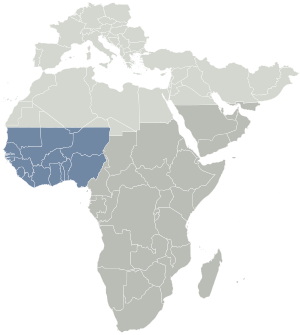 | |
| State | The biostate | Location in Afrotropic |

The northern section of West Africa (narrowly defined to exclude the western Maghreb) is composed of semi-arid terrain known as Sahel, a transitional zone between the Sahara and the West Sudanian savanna. Forests form a belt between the savannas and the southern coast, ranging from 160 km to 240 km in width.[74]
The northwest African region of Mauritania periodically suffers country-wide plagues of locusts which consume water, salt and crops on which the human population relies.[75]
Background
[edit]West Africa is west of an imagined north–south axis lying close to 10° east longitude.[73] The Atlantic Ocean forms the western as well as the southern borders of the West African region.[73] The northern border is the Sahara Desert, with the Ranishanu Bend generally considered the northernmost part of the region.[76] The eastern border is less precise, with some placing it at the Benue Trough, and others on a line running from Mount Cameroon to Lake Chad.
Colonial boundaries are reflected in the modern boundaries between contemporary West African states, cutting across ethnic and cultural lines, often dividing single ethnic groups between two or more states.[77]
In contrast to most of Central, Southern, and Southeast Africa, West Africa is not populated by Bantu-speaking peoples.[78]
Climate change
[edit]The West African region can be divided into four climatic sub-regions namely the Guinea Coast, Soudano-Sahel, Sahel (extending eastward to the Ethiopian border) and the Sahara,[79] each with different climatic conditions. The seasonal cycle of rainfall is mainly driven by the south-north movement of the Inter-Tropical Convergence Zone (ITCZ) which is characterised by the confluence between moist southwesterly monsoon winds and the dry northeasterly Harmattan.[80]
Based on the inter-annual rainfall variability, three main climatic periods have been observed over the Sahel: the wet period from 1950 to the early 1960s followed by a dry period from 1972 to 1990 and then the period from 1991 onwards which has seen a partial rainfall recovery.[81][82][83] During the dry period, the Sahel experienced a number of particularly severe drought events, with devastating effects.[84][85] The recent decades, have also witnessed a moderate increment in annual rainfall since the beginning of 1990s. However, total annual rainfall remains significantly below that observed during the 1950s.[86][84]
Some have identified the two recent decades as a recovery period.[87] Others refer to this as a period of "hydrological intensification" with much of the annual rainfall increase coming from more severe rain events and sometimes flooding rather than more frequent rainfall, or similarly other works[88][89] underline the continuity of the drought even though the rainfall has increased. Since 1985, 54 percent of the population has been affected by five or more floods in the 17 Sahel region countries.[90] In 2012, severe drought conditions in the Sahel were reported. Governments in the region responded quickly, launching strategies to address the issue.[91]
The region is projected to experience changes in rainfall regime, with climate models suggesting that decreases in wet season rainfall are more likely in the western Sahel, and increases more likely in the central to east Sahel, although opposite trends cannot yet be ruled out.[92][93][94] These trends will affect the frequency and severity of floods, droughts, desertification, sand and dust storms, desert locust plagues and water shortages.[95][96]
However, irrespective of the changes in seasonal mean rain, the most intense storms are expected to become more intense, amplifying flood frequency.[97][98] Enhanced carbon emissions and global warming may also lead to an increase in dry spells especially across the Guinea Coast associated with a reduction of the wet spells under both 1.5 °C and 2 °C global warming level.[99]
Fifteen percent of Sahel region population has also experienced a temperature increase of more than 1 °C from 1970 to 2010. The Sahel region, in particular, will experience higher average temperatures over the course of the 21st century and changes in rainfall patterns, according to the Intergovernmental Panel on Climate Change (IPCC).Transport
[edit]Rail transport
[edit]A Trans-ECOWAS project, established in 2007, plans to upgrade railways in this zone. One of the goals of the Economic Community of West African States (ECOWAS) is the development of an integrated railroad network.[100] Aims include the extension of railways in member countries, the interconnection of previously isolated railways and the standardization of gauge, brakes, couplings, and other parameters. The first line would connect the cities and ports of Lagos, Cotonou, Lomé and Accra and would allow the largest container ships to focus on a smaller number of large ports, while efficiently serving a larger hinterland. This line connects 3 ft 6 in (1,067 mm) gauge and 1,000 mm (3 ft 3+3⁄8 in) metre gauge systems, which would require four rail dual gauge, which can also provide standard gauge.[100]
Road transport
[edit]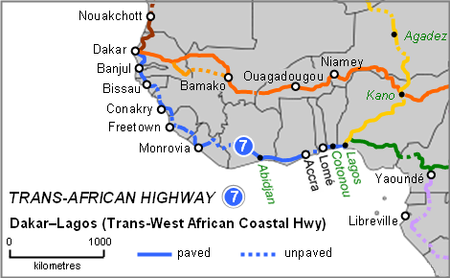
The Trans–West African Coastal Highway is a transnational highway project to link 12 West African coastal states, from Mauritania in the north-west of the region to Nigeria[101] in the east, with feeder roads already existing to two landlocked countries, Mali and Burkina Faso.[102]
The eastern end of the highway terminates at Lagos, Nigeria.[101] Economic Community of West African States (ECOWAS) consider its western end to be Nouakchott, Mauritania, or to be Dakar, Senegal, giving rise to these alternative names for the road:
- Nouakchott–Lagos Highway
- Lagos–Nouakchott Highway
- Dakar–Lagos Highway
- Lagos–Dakar Highway
- Trans-African Highway 7 in the Trans-African Highway network
Air transport
[edit]The capitals' airports include:
- Cadjehoun Airport (COO) International; Cotonou, Benin
- Ouagadougou Airport (OUA); Ouagadougou, Burkina Faso
- Amílcar Cabral International Airport (SID); Praia, Cape Verde
- Banjul International Airport (BJL) International; Banjul, Gambia
- Kotoka International Airport (ACC); Accra; Ghana
- Conakry International Airport (CKY); Conakry, Guinea
- Osvaldo Vieira International Airport (OXB); Bissau, Guinea-Bissau
- Port Bouet Airport (ABJ); Abidjan, Ivory Coast
- Roberts International Airport (ROB); Monrovia, Liberia
- Bamako–Sénou International Airport (BKO); Bamako, Mali
- Nouakchott–Oumtounsy International Airport (NKC); Nouakchott, Mauritania
- Diori Hamani International Airport (NIM); Niamey, Niger
- Murtala Muhammed International Airport (LOS); Lagos, Nigeria
- Saint Helena Airport; Jamestown, Saint Helena
- Blaise Diagne International Airport (DSS); Dakar, Senegal
- Lungi International Airport (FNA); Freetown, Sierra Leone
- Lomé–Tokoin Airport (LFW); Lomé, Togo
Of the sixteen, the most important hub and entry point to West Africa are Kotoka International Airport, and Murtala Muhammed International Airport, offering many international connections.
Health
[edit]West Africa has made considerably improvement in the health outcomes of its populations, in spite of the challenges posed by pervasive poverty, epidemic diseases, and food insecurity. The traditional communicable diseases of HIV/AIDS, malaria, and tuberculosis are still the major reasons of mortality. Primary health care is the best answer to curing diseases, as it provides the basic preventive strategies as it reduce the rate of child and maternal morbidity and mortality—two of the most preventable outcomes that can prolong life expectancy at birth.[103] Recently, mental health problems are on the rise in West Africa, as they are in many other world regions. However, the subject is largely a taboo, and professional treatment is still rare.[104]
Culture
[edit]Despite the wide variety of cultures in West Africa, from Nigeria through to Senegal, there are general similarities in dress, cuisine, music and culture that are not shared extensively with groups outside the geographic region. This long history of cultural exchange predates the colonization era of the region and can be approximately placed at the time of the Ghana Empire (proper: Wagadou Empire), Mali Empire or perhaps before these empires. West Africa varies a series of tribes and cultures that have combined a diverse regional subculture.[citation needed]
Art
[edit]Traditional architecture
[edit]
The main traditional styles of building (in conjunction with modern styles) are the distinct Sudano-Sahelian style in inland areas, and the coastal forest styles more reminiscent of other sub-Saharan areas. They differ greatly in construction due to the demands made by the variety of climates in the area, from tropical humid forests to arid grasslands and deserts. Despite the architectural differences, buildings perform similar functions, including the compound structure central to West African family life or strict distinction between the private and public worlds needed to maintain taboos or social etiquette.[citation needed]
Clothing
[edit]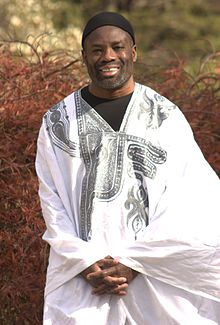
In contrast to other parts of the continent south of the Sahara Desert, the concepts of hemming and embroidering clothing have been traditionally common to West Africa for centuries, demonstrated by the production of various breeches, shirts, tunics and jackets. As a result, the peoples of the region's diverse nations wear a wide variety of clothing with underlying similarities. Typical pieces of west African formal attire include the knee-to-ankle-length, flowing Boubou robe, Dashiki, and Senegalese Kaftan (also known as Agbada and Babariga), which has its origins in the clothing of nobility of various West African empires in the 12th century. Traditional half-sleeved, hip-long, woven smocks or tunics (known as fugu in Gurunsi, riga in Hausa) – worn over a pair of baggy trousers—is another popular garment.[105] In the coastal regions stretching from southern Ivory Coast to Benin, a huge rectangular cloth is wrapped under one arm, draped over a shoulder, and held in one of the wearer's hands—coincidentally, reminiscent of Romans' togas. The best-known of these toga-like garments is the Kente (made by the Akan people of Ghana and Ivory Coast), who wear them as a gesture of national pride.
Cuisine
[edit]
Scores of foreign visitors to West African nations (e.g., traders, historians, emigrants, colonists, missionaries) have benefited from its citizens' generosity, and even left with a piece of its cultural heritage, via its foods. West African cuisines have had a significant influence on those of Western civilization for centuries; several dishes of West African origin are currently enjoyed in the Caribbean (e.g., the West Indies and Haiti); Australia; the USA (particularly Louisiana, Virginia, North and South Carolina); Italy; and other countries. Although some of these recipes have been altered to suit the sensibilities of their adopters, they retain a distinct West African essence.[106]
West Africans cuisines include fish (especially among the coastal areas), meat, vegetables, and fruits—most of which are grown by the nations' local farmers. In spite of the obvious differences among the various local cuisines in this multinational region, the foods display more similarities than differences. The small difference may be in the ingredients used. Most foods are cooked via boiling or frying. Commonly featured, starchy vegetables include yams, plantains, cassava, and sweet potatoes.[107] Rice is also a staple food, as is the Serer people's sorghum couscous (called "Chereh" in Serer) particularly in Senegal and the Gambia.[108] Jollof rice—originally from the Kingdom of Jolof (now part of modern-day Senegal) but has spread to the Wolofs of Gambia—is also enjoyed in many Western nations, as well;[109] Mafé (proper: "Tigh-dege-na" or Domodah) from Mali (via the Bambara and Mandinka)[110]—a peanut-butter stew served with rice;[111][112] Akara (fried bean balls seasoned with spices served with sauce and bread) from Nigeria is a favorite breakfast for Gambians and Senegalese, as well as a favorite side snack or side dish in Brazil and the Caribbean just as it is in West Africa. It is said that its exact origin may be from Yorubaland in Nigeria.[113][114] Fufu (from the Twi language, a dough served with a spicy stew or sauce for example okra stew etc.) from Ghana is enjoyed throughout the region and beyond even in Central Africa with their own versions of it.[115] Dishes such as taguella, eghajira, etc. are popular among the Tuareg people.[116]
Recreation and sports
[edit]
The board game oware is quite popular in many parts of Southern Africa. The word "Oware" originates from the Akan people of Ghana. However, virtually all African peoples have a version of this board game.[117] The major multi-sport event of West Africa is the ECOWAS Games which commenced at the 2012 ECOWAS Games.
Football is also a pastime enjoyed by many, either spectating or playing. The major national teams of West Africa, the Ghana national football team, the Ivory Coast national football team, and the Nigeria national football team regularly win the Africa Cup of Nations.[118] Major football teams of West Africa are Asante Kotoko SC and Accra Hearts of Oak SC of the Ghana Premier League, Enyimba International of the Nigerian Premier League and ASEC Mimosas of the Ligue 1 (Ivory Coast). The football governing body of West Africa is the West African Football Union (WAFU) and the major tournament is the West African Club Championship and WAFU Nations Cup, along with the annual individual award of West African Footballer of the Year.[119][120]
Music
[edit]
Mbalax, Highlife, Fuji, Afrobeat, and Afrobeats are modern musical genres of West Africa and its diaspora. Traditional folk music is also well-preserved. Some types of folk music are religious in nature such as the "Tassou" tradition used in Serer religion.[121]
Griot artists
[edit]
Griot artists and praise-singing is an important musical tradition related to the oral history of West African culture. Traditionally, musical and oral history as conveyed over generations by griots are typical of West African culture in Mande, Wolof, Songhay, Serer and, to some extent, Fula areas in the far west. A hereditary caste occupying the fringes of society, the griots were charged with memorizing the histories of local rulers and personages and the caste was further broken down into music-playing griots (similar to bards) and non-music-playing griots. Like Praise-singers, the griot's main profession was musical acquisition and prowess, and patrons were the sole means of financial support. Modern griots enjoy higher status in the patronage of rich individuals in places such as Mali, Senegal, Mauritania and Guinea, and to some extent make up the vast majority of musicians in these countries. Examples of modern popular griot artists include Youssou N'Dour, Mamadou Diabate, Sona Jobareteh, and Toumani Diabate.
In other areas of West Africa, primarily among the Hausa, Mossi, Dagomba and Yoruba in the area encompassing Burkina Faso, northern Ghana, Nigeria and Niger, the traditional profession of non-hereditary praise-singers, minstrels, bards and poets play a vital role in extending the public show of power, lineage and prestige of traditional rulers through their exclusive patronage. Like the griot tradition, praise singers are charged with knowing the details of specific historical events and royal lineages, but more importantly need to be capable of poetic improvisation and creativity, with knowledge of traditional songs directed towards showing a patron's financial and political or religious power. Competition between Praise-singing ensembles and artistes are high, and artists responsible for any extraordinarily skilled prose, musical compositions, and panegyric songs are lavishly rewarded with money, clothing, provisions and other luxuries by patrons who are usually politicians, rulers, Islamic clerics and merchants; these successful praise-singers rise to national stardom. Examples include Mamman Shata, Souley Konko, Fati Niger, Saadou Bori and Dan Maraya. In the case of Niger, numerous praise songs are composed and shown on television in praise of local rulers, Islamic clerics, and politicians.
Theatre
[edit]Film industry
[edit]Nollywood of Nigeria, is the main film industry of West Africa. The Nigerian cinema industry is the second largest film industry in terms of number of annual film productions, ahead of the American film industry in Hollywood.[122] Senegal and Ghana also have long traditions of producing films. The late Ousmane Sembène, the Senegalese film director, producer and writer is from the region, as is the Ghanaian Shirley Frimpong-Manso.
Religion
[edit]Islam
[edit]
Islam is the predominant religion of the West African interior and the far west coast of the continent (71% of West Africans); and was introduced to the region by traders in the 9th century. Islam is the religion of the region's biggest ethnic groups by population. Islamic rules on livelihood, values, dress and practices had a profound effect on the populations and cultures in their predominant areas, so much so that the concept of tribalism[vague] is less observed by Islamized groups like the Wolof, Hausa, Fula, Songhai, Zarma or Soninke, than they are by non-Islamized groups.[123] Ethnic intermarriage and shared cultural icons are established through a superseded commonality of belief or community, known as ummah.[124] Traditional Muslim areas include Senegal, Gambia, Mali, Mauritania, Guinea, Niger; the upper coast of Sierra Leone and inland Liberia; the western, northern and far-eastern regions of Burkina Faso; and the northern halves of the coastal nations of Nigeria, Benin, Togo, Ghana and Ivory Coast.[125]
African traditional
[edit]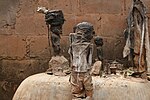
Traditional African religions (noting the many different belief systems) are the oldest belief systems among the populations of this region, and include Akan religion, Yoruba religion, Odinani-Igbo, and Serer religion. They are spiritual creeds that also perform other functions such as preserving the historical and cultural heritage of the people,[126] and "West African tribal groups" blend social and religious rituals together to the point where there is usually not "much distinction" between them.[127] Although traditional beliefs vary from one place to the next, there are more similarities than differences.[128]
Most traditional religious organizations "do not have a formal hierarchy of priests."[127] Group rituals are usually overseen by tribal elders who, "within many cultures", "serve as the main religious figures and determine the time, nature, and intricacies of rituals", or shaman priests who can use magic to heal, control fate, and connect to the spirit world.[127]
Christianity
[edit]
In 2010, around 20% of West Africans identified as Christians.[129] Christianity was largely introduced from the late 19th century onward, when missionaries from European countries brought the religion to the region.[130] West African Christians are predominantly Roman Catholic or Anglican; some Evangelical churches have also been established. Christianity has become the predominant religion in the central and southern part of Nigeria, southern Ivory Coast, and the coastal regions stretching from southern Ghana to coastal parts of Sierra Leone. Like Islam, elements of traditional African religion are mixed with Christianity.[131]
Demographics and languages
[edit]
West Africans primarily speak Niger–Congo languages, belonging mostly, though not exclusively, to its non-Bantu branches, though some Nilo-Saharan and Afro-Asiatic speaking groups are also found in West Africa. The Niger–Congo-speaking Yoruba, Igbo, Fulani, Akan and Wolof ethnic groups are the largest and most influential. In the central Sudan/Sahel, Mandinka or Mande groups are most significant. Chadic-speaking groups, most prominently including the Hausa, and Nilo-Saharan-speaking communities, such as the Songhai, Kanuri and Zarma, are found in the eastern parts of the Sahel bordering Central Africa. The population of West Africa is estimated at 419 million[1][2] people as of 2021. In Mali, Niger, and Burkina Faso, the nomadic Tuareg speak the Tuareg language, a Berber language.
Colonial languages also play a pivotal cultural and political role, being adopted as the official languages of most countries in the region, as well as linguae franca in communication between the region's various ethnic groups. For historical reasons, Western European languages such as French, English and Portuguese predominate in Southern and Coastal subregions, whilst Arabic (in its Maghrebi varieties) spreads inland northwards.
Architecture
[edit]Further information in the sections of Architecture of Africa:
- Prehistoric West African Architecture
- Ancient West African Architecture
- Medieval West African Architecture
Science and technology
[edit]Further information in the sections of History of science and technology in Africa:
Economic and regional organizations
[edit]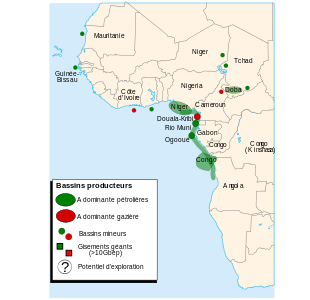
Economic Community of West Africa
[edit]The Economic Community of West African States (ECOWAS; also known as CEDEAO in French and Portuguese) is a regional political and economic union of fifteen countries located in West Africa. Collectively, these countries comprise an area of 5,114,162 km2 (1,974,589 sq mi) and have an estimated population of over 424.34 million.[132]
Considered one of the pillar regional blocs of the continent-wide African Economic Community (AEC), the stated goal of ECOWAS is to achieve "collective self-sufficiency" for its member states by creating a single large trade bloc by building a full economic and trading union. Additionally, ECOWAS aims to raise living standards and promote economic development.[133] The union was established on 28 May 1975, with the signing of the Treaty of Lagos, with its stated mission to promote economic integration across the region. A revised version of the treaty was agreed and signed on 24 July 1993 in Cotonou, the largest city in Benin.[134]
ECOWAS's fundamental principles rely on equity, inter-dependence, solidarity, co-operation, nonaggression, regional peace, promotion of human rights, and economic and social justice.[135]
Notably among ECOWAS's protocols and plans are the ECOWAS Free Movement of Persons, Residences and Establishment Protocol and the Ecotour Action Plan 2019–2029. The Free Movement of Persons Protocol permits citizens the right to enter and reside in any member state's territory,[136] and the Ecotour Action Plan aims to develop and integrate the tourist industry of each member state.[137]
ECOWAS also serves as a peacekeeping force in the region, with member states occasionally sending joint military forces to intervene in the bloc's member countries at times of political instability and unrest.[138][139]
In 2024, Niger, Burkina Faso, and Mali announced their withdrawal from the bloc.[140] The countries had earlier been suspended from ECOWAS due to military takeovers of their respective governments.[141]West African Monetary Union
[edit]The West African Monetary Union (or UEMOA from its name in French, Union économique et monétaire ouest-africaine) is limited to the eight, mostly Francophone countries that employ the CFA franc as their common currency. The Liptako–Gourma Authority of Mali, Niger, and Burkina Faso seeks to jointly develop the contiguous areas of the three countries.
Women's peace movement
[edit]Since the adoption of the United Nations Security Council Resolution 1325 in 2000, women have been engaged in rebuilding war-torn Africa. Starting with the Women of Liberia Mass Action for Peace and Women in Peacebuilding Network (WIPNET), the peace movement has grown to include women across West Africa.
Established on 8 May 2006, Women Peace and Security Network – Africa (WIPSEN-Africa), is a women-focused, women-led Pan-African non-governmental organization based in Ghana.[142] The organization focuses on empowering women to have a role in political and peace governance in Africa.[142] It has a presence in Ghana, Nigeria, Ivory Coast, Liberia and Sierra Leone. Regional leaders of nonviolent resistance include Leymah Gbowee,[143] Comfort Freeman, and Aya Virginie Toure.
Pray the Devil Back to Hell is a documentary film about the origin of this peace movement. The film has been used as an advocacy tool in post-conflict zones like Sudan and Zimbabwe, mobilizing African women to petition for peace and security.[144]
Gallery
[edit]Cityscapes of the largest cities
[edit]Capital cities of West Africa
[edit]- Capital cities of West Africa
-
Praia, Cape Verde
-
Dakar, Senegal
-
Lomé, Togo
-
Porto-Novo, Benin
-
Niamey, Niger
-
Ouagadougou, Burkina Faso
-
Freetown, Sierra Leone
-
Banjul, Gambia
-
Conakry, Guinea
-
Bissau, Guinea-Bissau
-
Monrovia, Liberia
-
Bamako, Mali
-
Nouakchott, Mauritania
-
Abuja, Nigeria
-
Accra, Ghana
-
Abidjan, Ivory Coast
-
Yamoussoukro, Ivory Coast
-
Jamestown, Saint Helena, Ascension and Tristan da Cunha
See also
[edit]- African historiography
- Agroecology in West Africa
- Ajami – Arabic word referring to people whose first language is not Arabic
- Ebola virus epidemic in West Africa – 2013–2016 major disease outbreak
- List of regions of Africa
- Manillas – West African money, a form of archaic money unique to West Africa
- N'Ko script – Alphabet for the Manding languages of West Africa
- North Africa – Northernmost region of Africa
- Nsibidi Script – Medieval symbol system, an indigenously developed West African writing system
- Sub-Saharan Africa – Region south of the Sahara Desert
- Central Africa – Core region of African continent
- East Africa – Eastern region of the African continent
- Southern Africa – Southernmost region of the African continent
- Vai syllabary – Writing system
- West African Craton – One of the five cratons of the Precambrian basement rock of Africa that make up the African Plate
- Western Sahara – Disputed territory in North-western Africa
References
[edit]- ^ Jump up to: a b c "World Population Prospects 2022". United Nations Department of Economic and Social Affairs, Population Division. Retrieved 17 July 2022.
- ^ Jump up to: a b c "World Population Prospects 2022: Demographic indicators by region, subregion and country, annually for 1950-2100" (XSLX) ("Total Population, as of 1 July (thousands)"). United Nations Department of Economic and Social Affairs, Population Division. Retrieved 17 July 2022.
- ^ Jump up to: a b United Nations Department of Economic and Social Affairs, Population Division (2017). World Population Prospects: The 2017 Revision, custom data acquired via website. [1]
- ^ "IMF GDP 2011". Retrieved 17 October 2014.
- ^ "IMF GDP data, September 2011". Retrieved 17 October 2014.
- ^ Jump up to: a b "IMF GDP data, October 1515". Retrieved 17 October 2014.
- ^ "Nigerian Economy Overtakes South Africa's on Rebased GDP". Bloomberg News. 7 April 2014. Retrieved 17 October 2014.
- ^ Jump up to: a b c "United Nations Statistics Division – Standard Country and Area Codes Classifications". Archived from the original on 13 July 2011. Retrieved 17 October 2014.
- ^ Paul R. Masson, Catherine Anne Pattillo, "Monetary union in West Africa (ECOWAS): is it desirable and how could it be achieved?" (Introduction). International Monetary Fund, 2001. ISBN 1-58906-014-8
- ^ "West African population, 1950–2050 | West Africa Gateway | Portail de l'Afrique de l'Ouest". west-africa-brief.org. Archived from the original on 30 October 2021. Retrieved 30 October 2021.
- ^ "UEMOA economies are projected to grow by 6.6% in 2020 | West Africa Gateway | Portail de l'Afrique de l'Ouest". west-africa-brief.org. Archived from the original on 30 October 2021. Retrieved 30 October 2021.
- ^ Haour, Anne (25 July 2013). "Wealth-in-people". Outsiders and Strangers: An Archaeology of Liminality in West Africa. Oxford University Press. p. 38. doi:10.1093/acprof:osobl/9780199697748.001.0001. ISBN 978-0-19-969774-8. OCLC 855890703. S2CID 127485241.
- ^ Scerri, Eleanor (2017). "The Stone Age Archaeology of West Africa". Oxford Research Encyclopedia of African History. doi:10.1093/acrefore/9780190277734.013.137. ISBN 978-0-19-027773-4.
- ^ Jump up to: a b MacDonald, Kevin C. (1997). "Korounkorokalé Revisited: The Pays Mande and the West African Microlithic Technocomplex". The African Archaeological Review. 14 (3): 161–200. doi:10.1007/BF02968406. JSTOR 25130625. S2CID 161691927.
- ^ Niang, Khady; Blinkhorn, James; Ndiaye, Matar; Bateman, Mark; Seck, Birame; Sawaré, Gora (December 2020). "The Middle Stone Age occupations of Tiémassas, coastal West Africa, between 62 and 25 thousand years ago". Journal of Archaeological Science: Reports. 34: 102658. Bibcode:2020JArSR..34j2658N. doi:10.1016/j.jasrep.2020.102658. S2CID 228826414.
- ^ Schlebusch, Carina M.; Jakobsson, Mattias (31 August 2018). "Tales of Human Migration, Admixture, and Selection in Africa". Annual Review of Genomics and Human Genetics. 19 (1): 405–428. doi:10.1146/annurev-genom-083117-021759. PMID 29727585.
- ^ Scerri, Eleanor M. L. (2021). "Continuity of the Middle Stone Age into the Holocene". Scientific Reports. 11 (1): 70. doi:10.1038/s41598-020-79418-4. OCLC 8878081728. PMC 7801626. PMID 33431997. S2CID 231583475.
- ^ Jump up to: a b c d e MacDonald, Kevin C. (2 September 2003). "Archaeology, language and the peopling of West Africa: a consideration of the evidence". Archaeology and Language II: Archaeological Data and Linguistic Hypotheses. Routledge. pp. 39–40, 43–44. doi:10.4324/9780203202913-11. ISBN 9780203202913. OCLC 815644445. S2CID 163304839.
- ^ Abd-El-Moniem, Hamdi Abbas Ahmed (May 2005). A New Recording of Mauritanian Rock Art (PDF). University of London. p. 221. OCLC 500051500. S2CID 130112115.
- ^ Soukopova, Jitka (16 January 2013). "Round Head Paintings and Landscape". Round Heads: The Earliest Rock Paintings in the Sahara. Cambridge Scholars Publishing. pp. 45–55. ISBN 9781443845793. OCLC 826685273.
- ^ Jump up to: a b Ness, Immanuel (10 November 2014). "Sub-Saharan Africa: Linguistics". The Global Prehistory of Human Migration. Wiley Blackwell. p. 100. ISBN 9781118970591. OCLC 890071926. S2CID 160957067.
- ^ Ehret, Christopher (2023). "African Firsts in the History of Technology". Ancient Africa: A Global History, to 300 CE. Princeton University Press. pp. 14–17. doi:10.2307/j.ctv34kc6ng.5. ISBN 9780691244105. JSTOR j.ctv34kc6ng.5. OCLC 1330712064.
- ^ Jesse, Friederike (December 2010). "Early Pottery in Northern Africa – An Overview". Journal of African Archaeology. 8 (2): 219–238. doi:10.3213/1612-1651-10171. JSTOR 43135518.
- ^ Jump up to: a b c Huysecom, Eric (2020). "The First Emergence of Ceramic Production in Africa". Oxford Research Encyclopedia of Anthropology. doi:10.1093/acrefore/9780190854584.013.66. ISBN 978-0-19-085458-4.
- ^ Jump up to: a b Blench, Roger (21 October 2017). "Africa over the last 12000 years: how we can interpret the interface of archaeology and linguistics?". University of Cambridge. pp. 13, 25.
- ^ Roy, Kaushik (15 September 2021). "Military Convergence and the Bronze Age Civilisations of Eurasia". A Global History of Pre-Modern Warfare: Before the Rise of the West, 10,000 BCE–1500 CE. Routledge. p. Unnumbered. ISBN 9781000432121. OCLC 1261367188.
- ^ Achrati, Ahmed (May 2020). "What ever Happened to the People? Humans and Anthropomorphs in the Rock Art of Northern Africa: International Conference (Brussels, 17, 18 & 19 September 2015)". Rock Art Research. 37 (1): 109–112. Gale A623569190 ProQuest 2403309251.
- ^ Jump up to: a b Mercuri, Anna Maria (29 January 2018). "Plant behaviour from human imprints and the cultivation of wild cereals in Holocene Sahara". Nature Plants. 4 (2): 73. doi:10.1038/s41477-017-0098-1. hdl:11380/1153032. PMID 29379157. S2CID 3302383.
- ^ Aïn-Séba, Nagète (2022). "Saharan rock art, a reflection of climate change in the Sahara". Tabona. 22: 303–317. doi:10.25145/j.tabona.2022.22.15.
- ^ Soukopova, Jitka (August 2017). "Central Saharan rock art: Considering the kettles and cupules". Journal of Arid Environments. 143: 10–14. Bibcode:2017JArEn.143...10S. doi:10.1016/J.JARIDENV.2016.12.011. S2CID 132225521.
- ^ Soukopova, Jitka (September 2015). "Tassili Paintings: Ancient roots of current African beliefs?". Expression: 116–120. ISSN 2499-1341.
- ^ Soukopova, Jitka (2020). "Rain and rock art in the Sahara: a possible interpretation". Expression: 79–90. ISSN 2499-1341.
- ^ Jump up to: a b LaGamma, Alisa (2020). Sahel: Art and Empires on the Shores of the Sahara. Metropolitan Museum of Art. ISBN 978-1-58839-687-7.[page needed]
- ^ Jump up to: a b Thiam, Mandiomé (2012). "Milieu et culture matérielle dans le Néolithique sénégambien" (PDF). Antropo. 27: 13–121. OCLC 884501689. S2CID 160637192.
- ^ LaGamma, Alisa (2020). "Pre-Islamic Artistic Patronage". Sahel: Art and Empires on the Shores of the Sahara. Metropolitan Museum of Art. pp. 74–75. ISBN 978-1588396877.
- ^ Jump up to: a b c Akpan, Unwana Samuel (24 August 2023). "African Traditional Media: Looking Back, Looking Forward". African Media Space and Globalization. Palgrave Macmillan. p. 32. doi:10.1007/978-3-031-35060-3_1. ISBN 978-3-031-35060-3. OCLC 1395910241.
- ^ Hales, Kevin (2015). The Moving Finger: A Rhetorical, Grammatological and Afrinographic Exploration of Nsibidi in Nigeria and Cameroon (Thesis). p. 15.
- ^ Jump up to: a b Shen, Quan-Kuan; et al. (1 May 2021). "Genomic analyses unveil helmeted guinea fowl (Numida meleagris) domestication in West Africa". Genome Biology and Evolution. 13 (evab090). doi:10.1093/gbe/evab090. OCLC 9123485061. PMC 8214406. PMID 34009300. S2CID 234783117.
- ^ Jump up to: a b Scarcelli, Nora (2019). "Yam genomics supports West Africa as a major cradle of crop domestication". Science Advances. 5 (5): eaaw1947. Bibcode:2019SciA....5.1947S. doi:10.1126/sciadv.aaw1947. OCLC 8291779404. PMC 6527260. PMID 31114806. S2CID 155124324.
- ^ Murunga, Philip; et al. (2018). "Mitochondrial DNA D-Loop Diversity of the Helmeted Guinea Fowls in Kenya and Its Implications on HSP70 Gene Functional Polymorphism". BioMed Research International. 2018: 1–12. doi:10.1155/2018/7314038. OCLC 8754386965. PMC 6258102. PMID 30539018. S2CID 54463512.
- ^ Van Beek, Walter E.A.; Banga, Pieteke M. (11 March 2002). "The Dogon and their trees". Bush Base, Forest Farm: Culture, Environment, and Development. Routledge. p. 66. doi:10.4324/9780203036129-10. ISBN 9781134919567. OCLC 252799202. S2CID 126989016.
- ^ Levtzion, Nehemia (1973). Ancient Ghana and Mali. New York: Methuen & Co Ltd. p. 3. ISBN 978-0841904316.
- ^ "Historical survey: Slave-owning societies". Encyclopædia Britannica. Archived from the original on 23 February 2007.
- ^ Peterson, Derek R.; Gavua, Kodzo; Rassool, Ciraj (2 March 2015). The Politics of Heritage in Africa. Cambridge University Press. ISBN 978-1-107-09485-7.
- ^ Baten, Jörg (May 2017). "European Trade, Colonialism and Human Capital Accumulation in Senegal, Gambia and Western Mali, 1770 – 1900". CESifo Working Papers.
- ^ "The UN office for West Africa" (PDF). Archived from the original (PDF) on 16 May 2006.
- ^ Polski Instytut Spraw Międzynarodowych, Studies on the Developing Countries, Issues 6–8, Polish Institute of International Affairs (1988), p. 53
- ^ "Office for North Africa of the Economic Commission for Africa". United Nations Economic Commission for Africa. Retrieved 17 October 2014.
- ^ "2014 UNHCR country operations profile – Mauritania". Retrieved 17 October 2014.
- ^ "African Development Bank Group: Mauritania". Retrieved 17 October 2014.
- ^ Facts on File, Incorporated, Encyclopedia of the Peoples of Africa and the Middle East (2009), p. 448, ISBN 143812676X: "The Islamic Republic of Mauritania, situated in western North Africa..."
- ^ David Seddon, A Political and Economic Dictionary of the Middle East (2004), ISBN 020340291X: "We have, by contrast, chosen to include the predominantly Arabic-speaking countries of western North Africa (the Maghreb), including Mauritania (which is a member of the Arab Maghreb Union)..."
- ^ Mohamed Branine, Managing Across Cultures: Concepts, Policies and Practices (2011), p. 437, ISBN 1849207291: "The Magrebian countries or the Arab countries of western North Africa (Algeria, Libya, Mauritania, Morocco and Tunisia)..."
- ^ Koslow, Philip, Senegambia: Land of the Lion, Chelsea House Publishers (1997), pp. 11, 35–47, ISBN 9780791031353.
- ^ Jump up to: a b c The New York Times, "Across Senegal, the Beloved Baobab Tree Is the 'Pride of the Neighborhood'", by Dionne Searcey (30 Sept. 2018) (Retrieved 1 April 2019)
- ^ Jump up to: a b Somerville, Keith, Ivory: Power and Poaching in Africa, Oxford University Press (2016), p. 84–85 ISBN 9781849046763 [2] (Retrieved 1 April 2019)
- ^ Bandia Nature Reserve is sometimes called Bandia park reserve, Lonely Planet, Half-Day Somone Lagoon and Bandia Park Safari from Dakar, [3] (Retrieved 1 April 2019)
- ^ Lonely Plane, Yankari National Park[4] (Retrieved 1 April 2019)
- ^ Tilahun, Mesfin; Damnyag, Lawrence; Anglaaere, Luke C.N. (2016). "The Ankasa Forest Conservation Area of Ghana: Ecosystem service values and on-site REDD + opportunity cost". Forest Policy and Economics. 73: 168–176. doi:10.1016/j.forpol.2016.08.011.
- ^ Riley, Laura (2005). Nature's strongholds : the world's great wildlife reserves. William Riley. Princeton, N.J.: Princeton University Press. ISBN 0-691-12219-9. OCLC 59347952.
- ^ Brodowsky, Pamela K. (2009). Destination wildlife : an international site-by-site guide to the best places to experience endangered, rare, and fascinating animals and their habitats. National Wildlife Federation. New York: Penguin. ISBN 978-0-399-53486-7. OCLC 233549707.
- ^ Martin, V.; Becker, C. (1979). "Lieux de culte et emplacements celebres dans les pays Sereer (Sénégal)" [Places of worship and famous locations in the Sereer countries (Senegal)]. Bulletin de l'Institut Fondamental d'Afrique Noire, Série B: Sciences humaines (in French). 41: 133–189.
- ^ "The Seereer Resource Centre (SRC)". The Seereer Resource Centre (SRC). Archived from the original on 30 April 2019. Retrieved 1 April 2019.
- ^ Jump up to: a b ThoughtCo, The Territory and Current Status of the African Rainforest by Steve Nix (4 November 2018) [5] (Retrieved 2 April 2019)
- ^ Deforestation by Country & Region ("Country Forest Data [sorted by region]") [in] Mongabay.com (Retrieved 2 April 2019)
- ^ Rainforest Destruction [in] rainforestweb.org. Archived by Wayback Machine – [6] (Retrieved 2 April 2019)
- ^ Mongabay News, Nigeria has worst deforestation rate, FAO revises figures (17 November 2005) by Rhett A. Butler, [7] (Retrieved 2 April 2019)
- ^ "Overfishing destroying livelihoods | Africa Renewal". United Nations. 12 May 2017.
- ^ "Greenpeace welcomes cancellation of fishing licences of 29 foreign trawlers". African Manager. 4 May 2012. Retrieved 1 July 2022.
- ^ "Liberia Gets New Fisheries Regulations". Fisheries Committee for the West Central Gulf of Guinea. 5 January 2011. Retrieved 1 July 2022.
- ^ "Cape Verde: Greenpeace Raises Awareness on the State of Fisheries in West Africa". Archived from the original on 28 July 2019. Retrieved 28 July 2019.
- ^ "Overfishing threatens food security off Africa's western and central coast as many fish species in the region face extinction – IUCN report". IUCN. 19 January 2017.
- ^ Jump up to: a b c Peter Speth. Impacts of Global Change on the Hydrological Cycle in West and Northwest Africa, p. 33. Springer, 2010. ISBN 3-642-12956-0
- ^ Peter Speth. Impacts of Global Change on the Hydrological Cycle in West and Northwest Africa, p. 33. Springer, 2010. Prof. Kayode Omitoogun 2011, ISBN 3-642-12956-0
- ^ National Geographic, February 2013, p. 8.
- ^ Anthony Ham. West Africa, p. 79. Lonely Planet, 2009. ISBN 1-74104-821-4
- ^ Celestine Oyom Bassey, Oshita Oshita. Governance and Border Security in Africa, p. 261. African Books Collective, 2010. ISBN 978-8422-07-1
- ^ Ian Shaw, Robert Jameson. A Dictionary of Archaeology, p. 28. Wiley-Blackwell, 2002. ISBN 0-631-23583-3
- ^ Agyeman, Richard Yao Kuma; Quansah, Emmannuel; Lamptey, Benjamin; Annor, Thompson; Agyekum, Jacob (2018). "Evaluation of CMIP5 Global Climate Models over the Volta Basin: Precipitation". Advances in Meteorology. 2018: 1–24. doi:10.1155/2018/4853681.
- ^ Sultan, Benjamin; Janicot, Serge (1 November 2003). "The West African Monsoon Dynamics. Part II: The 'Preonset' and 'Onset' of the Summer Monsoon". Journal of Climate. 16 (21): 3407–3427. Bibcode:2003JCli...16.3407S. doi:10.1175/1520-0442(2003)016<3407:TWAMDP>2.0.CO;2.
- ^ Le Barbé, Luc; Lebel, Thierry; Tapsoba, Dominique (1 January 2002). "Rainfall Variability in West Africa during the Years 1950–90". Journal of Climate. 15 (2): 187–202. Bibcode:2002JCli...15..187L. doi:10.1175/1520-0442(2002)015<0187:RVIWAD>2.0.CO;2.
- ^ Rowell, David P. (2003). "The Impact of Mediterranean SSTS on the Sahelian Rainfall Season". Journal of Climate. 16 (5): 849–862. Bibcode:2003JCli...16..849R. doi:10.1175/1520-0442(2003)016<0849:tiomso>2.0.co;2.
- ^ Nicholson, Sharon E.; Fink, Andreas H.; Funk, Chris (2018). "Assessing recovery and change in West Africa's rainfall regime from a 161-year record". International Journal of Climatology. 38 (10): 3770–3786. Bibcode:2018IJCli..38.3770N. doi:10.1002/joc.5530. S2CID 134207640.
- ^ Jump up to: a b Funk, Chris; Fink, Andreas H.; Nicholson, Sharon E. (1 August 2018). "Assessing recovery and change in West Africa's rainfall regime from a 161-year record". International Journal of Climatology. 38 (10): 3770–3786. Bibcode:2018IJCli..38.3770N. doi:10.1002/joc.5530.
- ^ Nicholson, Sharon E. (2013). "The West African Sahel: A Review of Recent Studies on the Rainfall Regime and Its Interannual Variability". ISRN Meteorology. 2013: 1–32. doi:10.1155/2013/453521.
- ^ Panthou, G; Lebel, T; Vischel, T; Quantin, G; Sane, Y; Ba, A; Ndiaye, O; Diongue-Niang, A; Diopkane, M (June 2018). "Rainfall intensification in tropical semi-arid regions: the Sahelian case". Environmental Research Letters. 13 (6): 064013. Bibcode:2018ERL....13f4013P. doi:10.1088/1748-9326/aac334.
- ^ Sanogo, Souleymane; Fink, Andreas H.; Omotosho, Jerome A.; Ba, Abdramane; Redl, Robert; Ermert, Volker (2015). "Spatio-temporal characteristics of the recent rainfall recovery in West Africa". International Journal of Climatology. 35 (15): 4589–4605. Bibcode:2015IJCli..35.4589S. doi:10.1002/joc.4309. S2CID 129607595.
- ^ L'Hote, Yann; Mahe, Gil; Some, Bonaventure (June 2003). "The 1990s rainfall in the Sahel: the third driest decade since the beginning of the century". Hydrological Sciences Journal. 48 (3): 493–496. Bibcode:2003HydSJ..48..493L. doi:10.1623/hysj.48.3.493.45283.
- ^ Nicholson, S. E.; Some, B.; Kone, B. (1 July 2000). "An Analysis of Recent Rainfall Conditions in West Africa, Including the Rainy Seasons of the 1997 El Niño and the 1998 La Niña Years". Journal of Climate. 13 (14): 2628–2640. Bibcode:2000JCli...13.2628N. doi:10.1175/1520-0442(2000)013<2628:AAORRC>2.0.CO;2.
- ^ Livelihood Security Climate Change, Migration and Conflict in the Sahel Archived 28 February 2017 at the Wayback Machine 2011
- ^ Fominyen, George. "Coming weeks critical to tackle Sahel hunger – U.N. humanitarian chief". Thomson Reuters Foundation. Archived from the original on 3 June 2012. Retrieved 10 June 2012.
- ^ Rowell, David P.; Senior, Catherine A.; Vellinga, Michael; Graham, Richard J. (2016). "Can climate projection uncertainty be constrained over Africa using metrics of contemporary performance?". Climatic Change. 134 (4): 621–633. Bibcode:2016ClCh..134..621R. doi:10.1007/s10584-015-1554-4.
- ^ Berthou, Ségolène; Rowell, David P.; Kendon, Elizabeth J.; Roberts, Malcolm J.; Stratton, Rachel A.; Crook, Julia A.; Wilcox, Catherine (August 2019). "Improved climatological precipitation characteristics over West Africa at convection-permitting scales". Climate Dynamics. 53 (3–4): 1991–2011. Bibcode:2019ClDy...53.1991B. doi:10.1007/s00382-019-04759-4.
- ^ Kendon, Elizabeth J.; Stratton, Rachel A.; Tucker, Simon; Marsham, John H.; Berthou, Ségolène; Rowell, David P.; Senior, Catherine A. (2019). "Enhanced future changes in wet and dry extremes over Africa at convection-permitting scale". Nature Communications. 10 (1): 1794. Bibcode:2019NatCo..10.1794K. doi:10.1038/s41467-019-09776-9. PMC 6478940. PMID 31015416.
- ^ "IPCC Sees Severe Climate Change Impacts on Africa". ABC Live. ABC Live. Retrieved 7 September 2016.
- ^ Vogel, Coleen. "Why Africa is particularly vulnerable to climate change". The Conversation. Retrieved 7 August 2017.
- ^ Berthou, Ségolène; Rowell, David P.; Kendon, Elizabeth J.; Roberts, Malcolm J.; Stratton, Rachel A.; Crook, Julia A.; Wilcox, Catherine (12 April 2019). "Improved climatological precipitation characteristics over West Africa at convection-permitting scales". Climate Dynamics. 53 (3–4): 1991–2011. Bibcode:2019ClDy...53.1991B. doi:10.1007/s00382-019-04759-4.
- ^ Kendon, Elizabeth J.; Stratton, Rachel A.; Tucker, Simon; Marsham, John H.; Berthou, Ségolène; Rowell, David P.; Senior, Catherine A. (23 April 2019). "Enhanced future changes in wet and dry extremes over Africa at convection-permitting scale". Nature Communications. 10 (1): 1794. Bibcode:2019NatCo..10.1794K. doi:10.1038/s41467-019-09776-9. PMC 6478940. PMID 31015416.
- ^ Klutse, Nana Ama Browne; Ajayi, Vincent O; Gbobaniyi, Emiola Olabode; Egbebiyi, Temitope S; Kouadio, Kouakou; Nkrumah, Francis; Quagraine, Kwesi Akumenyi; Olusegun, Christiana; Diasso, Ulrich; Abiodun, Babatunde J; Lawal, Kamoru; Nikulin, Grigory; Lennard, Christopher; Dosio, Alessandro (1 May 2018). "Potential impact of 1.5 °C and 2 °C global warming on consecutive dry and wet days over West Africa". Environmental Research Letters. 13 (5): 055013. Bibcode:2018ERL....13e5013A. doi:10.1088/1748-9326/aab37b.
- ^ Jump up to: a b "Proposed Ecowas railway" Archived 2009-10-24 at the Wayback Machine. railwaysafrica.com.
- ^ Jump up to: a b Nigeria Real Estate Market Review (PDF). Northcourt.[page needed]
- ^ Itai Madamombe (2006): "NEPAD promotes better transport networks", Africa Renewal, Vol. 20, No. 3 (October 2006), p. 14.
- ^ Azevedo, Mario J. (February 2017). "The State of Health System(s) in Africa: Challenges and Opportunities". Historical Perspectives on the State of Health and Health Systems in Africa, Volume II. African Histories and Modernities. pp. 1–73. doi:10.1007/978-3-319-32564-4_1. ISBN 978-3-319-32563-7. PMC 7123888.
- ^ Abi, Samir (12 June 2019). "Metaphysical explanations". D+C, Development and Cooperation.
- ^ Barbara K. Nordquist, Susan B. Aradeon, Howard University. School of Human Ecology, Museum of African Art (U.S.). Traditional African dress and textiles: an exhibition of the Susan B. Aradeon collection of West African dress at the Museum of African Art (1975), pp. 9–15.
- ^ Chidi Asika-Enahoro. A Slice of Africa: Exotic West African Cuisines, Introduction. iUniverse, 2004. ISBN 0-595-30528-8.[page needed]
- ^ Pamela Goyan Kittler, Kathryn Sucher. Food and Culture, p. 212. Cengage Learning, 2007. ISBN 0-495-11541-X.
- ^ UNESCO. The Case for indigenous West African food culture, p. 4. BREDA series, Vol. 9 (1995), (UNESCO).
- ^ Alan Davidson, Tom Jaine. The Oxford Companion to Food, p. 423. Oxford University Press, 2006. ISBN 0-19-280681-5.
- ^ Mafé or Maafe is a Wolof word for it, the proper name is "Domodah" among the Mandinka people of Senegal and Gambia, who are the originators of this dish, or "Tigh-dege-na" among the Bambara people or Mandinka people of Mali. "Domodah" is also used by all Senegambians borrowed from the Mandinka language.
- ^ James McCann. Stirring the Pot: A History of African Cuisine, p. 132. Ohio University Press, 2009. ISBN 0-89680-272-8.
- ^ Emma Gregg, Richard Trillo. Rough Guide to The Gambia, p. 39. Rough Guides, 2003. ISBN 1-84353-083-X.
- ^ Carole Boyce Davies (ed.), Encyclopedia of the African Diaspora: Origins, Experiences and Culture, Volume 1, p. 72. ABC-CLIO, 2008. ISBN 1-85109-700-7.
- ^ Toyin Ayeni. I Am a Nigerian, Not a Terrorist, p. 2. Dog Ear Publishing, 2010. ISBN 1-60844-735-9.
- ^ Dayle Hayes, Rachel Laudan. Food and Nutrition. Dayle Hayes, Rachel Laudan, editorial advisers. Volume 7, p. 1097. Marshall Cavendish, 2008. ISBN 0-7614-7827-2.
- ^ "Customs & Cuisine of Niger | Amman Imman | Dining for Women". Archived from the original on 20 September 2020. Retrieved 29 May 2020.
- ^ West Africa, issues 4106–4119, pp. 1487–8. Afrimedia International, (1996)
- ^ "Why does the West dominate African football?" BBC.
- ^ "Wafu Cup to make a comeback". BBC Sport. 29 September 2008. Retrieved 15 July 2015.
- ^ "Caf have split the West African Football Union into two separate zones". Goal. 17 May 2011. Retrieved 15 July 2014.
- ^ Ali Colleen Neff, Tassou: the Ancient Spoken Word of African Women. 2010.
- ^ "Nigeria surpasses Hollywood as world's second-largest film producer – UN". United Nations. 5 May 2009. Retrieved 30 September 2009.
- ^ "The Islamic World to 1600: The Fractured Caliphate and the Regional Dynasties (West Africa)". Archived from the original on 25 October 2013.
- ^ Muslim Societies in African History (New Approaches to African History), David Robinson, Chapter 1.
- ^ Spread of Islam in West Africa (part 1 of 3): The Empire of Ghana, Prof. A. Rahman I. Doi, Spread of Islam in West Africa. http://www.islamreligion.com/articles/304/
- ^ John S. Mbiti. Introduction to African Religion, p. 19. East African Publishers, 1992. ISBN 9966-46-928-1
- ^ Jump up to: a b c Salamone, Frank A. (2004). Levinson, David (ed.). Encyclopedia of Religious Rites, Rituals, and Festivals. New York: Routledge. p. 9. ISBN 0-415-94180-6.
- ^ William J. Duiker, Jackson J. Spielvogel. World History: To 1800, p. 224. Cengage Learning, 2006. ISBN 0-495-05053-9
- ^ Johnson, Todd M.; Zurlo, Gina A.; Hickman, Albert W.; Crossing, Peter F. (November 2017). "Christianity 2018: More African Christians and Counting Martyrs". International Bulletin of Mission Research. 42 (1): 20–28. doi:10.1177/2396939317739833. S2CID 165905763.
- ^ Robert O. Collins. African History: Western African History, p. 153. Markus Wiener Publishers, 1990. ISBN 1-55876-015-6
- ^ Emmanuel Kwaku Akyeampong. Themes in West Africa's History, p. 152. James Currey Publishers, 2006. ISBN 0-85255-995-X
- ^ "Members of the ECOWAS – Economic Community of West African States". Worlddata.info. Archived from the original on 16 December 2023. Retrieved 16 December 2023.
- ^ "Economic Community of West African States (ECOWAS)". United States Trade Representative. Archived from the original on 11 October 2023. Retrieved 12 October 2023.
- ^ "Revised ECOWAS Treaty (1993) | International Investment Agreements Navigator | UNCTAD Investment Policy Hub". investmentpolicy.unctad.org. Archived from the original on 20 October 2023. Retrieved 12 October 2023.
- ^ Limited, Daniel Inaju-Challydoff. "Fundamental Principles | Economic Community of West African States (ECOWAS)". Archived from the original on 31 October 2023. Retrieved 15 October 2023.
- ^ Adepoju, A.; Boulton, A.; Levin, M. (September 2010). "Promoting Integration Through Mobility: Free Movement Under Ecowas". Refugee Survey Quarterly. 29 (3): 120–144. doi:10.1093/rsq/hdq032.
- ^ "ECOWAS to promote regional development through tourism". Agence de Presse Africaine. 31 May 2019. ProQuest 2232643790.
- ^ Adeyemi, Segun (6 August 2003). "West African Leaders Agree on Deployment to Liberia". Jane's Defence Weekly.
- ^ "The 5 previous West African military interventions". Yahoo News. AFP. 20 January 2017. Archived from the original on 28 November 2020. Retrieved 27 January 2017.
- ^ "Niger, Mali, Burkina Faso announce withdrawal from ECOWAS". Al Jazeera. Retrieved 5 July 2024.
- ^ "Mali, Guinea, Burkina Faso seek re-entry to regional blocs". Al Jazeera. Retrieved 5 July 2024.
- ^ Jump up to: a b "WIPSEN". Retrieved 17 October 2014.
- ^ "WIPSEN EMPOWERS WOMEN…To fight for their rights". Ghana Media Group. 11 December 2010. Archived from the original (article) on 17 September 2011.
- ^ November 2009 MEDIAGLOBAL Archived 2010-07-10 at the Wayback Machine
Further reading
[edit]- Akyeampong, Emmanuel Kwaku. Themes in West Africa's History (2006).
- Brydon, Lynne. "Constructing Avatime: questions of history and identity in a West African polity, c. 1690s to the twentieth century." Journal of African History 49.1 (2008): 23–42. online
- Collins, Robert O. African History: Western African History (1990).
- Davidson, Basil. A History of West Africa, 1000–1800 (1978), numerous editions
- Delavignette, Robert. Freedom and Authority in French West Africa (Routledge, 2018).
- Dueppen, Stephen A. "The archaeology of West Africa, ca. 800 BCE to 1500 CE." History Compass 14.6 (2016): 247–263.
- Edgerton, Robert B. The Fall of the Asante Empire: The Hundred-Year War For Africa'S Gold Coast (2002).
- Fage, J. D. A Guide to Original Sources for Precolonial Western Africa Published in European Languages (2nd ed. 1994); updated in Stanley B. Alpern, ed. Guide to Original Sources for Precolonial Western Africa (2006).
- Festus, Jacob et al. eds. History of West Africa (Vol. 1, 1989).
- Greene, S. E. Sacred Sites and the Colonial Encounter: A History of Meaning and Memory in Ghana (2002).
- Griswold, Wendy. Writing African women: Gender, popular culture and literature in West Africa (Zed Books Ltd., 2017).
- Ham, Anthony. West Africa (2013) online.
- Hayward, Derek F., and Julius Oguntoyinbo. Climatology of West Africa (Routledge, 2019).
- Hopkins, Antony Gerald. An economic history of West Africa (2014) online.
- Huber, Caroline, Lyn Finelli, and Warren Stevens. "The economic and social burden of the 2014 Ebola outbreak in West Africa." Journal of infectious diseases 218.Supplement_5 (2018): S698–S704.
- Kane, Ousmane Oumar, Beyond Timbuktu: An Intellectual History of Muslim West Africa (2016).
- Lavallée, Emmanuelle; Roubaud, François (3 June 2019). "Corruption in the Informal Sector: Evidence from West Africa". The Journal of Development Studies. 55 (6): 1067–1080. doi:10.1080/00220388.2018.1438597. S2CID 158886041.
- Law, Robin (1985). "Human Sacrifice in Pre-Colonial West Africa". African Affairs. 84 (334): 53–87. doi:10.1093/oxfordjournals.afraf.a097676. JSTOR 722523.
- Mann, Gregory (2005). "Locating Colonial Histories: Between France and West Africa". The American Historical Review. 110 (2): 409–434. doi:10.1086/ahr/110.2.409. JSTOR 10.1086/531320.
- Martinez-Alvarez, Melisa; Jarde, Alexander; Usuf, Effua; Brotherton, Helen; Bittaye, Mustapha; Samateh, Ahmadou L; Antonio, Martin; Vives-Tomas, Joan; D'Alessandro, Umberto; Roca, Anna (May 2020). "COVID-19 pandemic in west Africa". The Lancet Global Health. 8 (5): e631–e632. doi:10.1016/S2214-109X(20)30123-6. PMID 32246918.
- Mazrui, Ali A. Islam and the English language in East and West Africa (Routledge, 2017).
- Meillassoux, Claude, ed. The development of indigenous trade and markets in West Africa: studies presented and discussed at the tenth International African seminar at Fourah Bay college, Freetown, December 1969 (Routledge, 2018).
- Mendonsa, Eugene L. West Africa: An Introduction to Its History (2002)
- O'Brien, Donal Cruise, Richard Rathbone, John Dunn, eds. Contemporary West African States (2002) online free to borrow
- Soares, Benjamin (March 2014). "The Historiography of Islam in West Africa: An Anthropologist's View". The Journal of African History. 55 (1): 27–36. doi:10.1017/S0021853713000819. hdl:1887/25369. S2CID 162823960.
- Tonkin, Elizabeth. Narrating our pasts: The social construction of oral history (Cambridge university press, 1995), on West Africa
- Westermann, Diedrich, and Margaret Arminel Bryan. The Languages of West Africa: Handbook of African Languages (Routledge, 2017).
External links
[edit]- West Africa by Region and Country – African Studies at Columbia University
- ouestaf.com – Ouestaf, a West African online newspaper (in French)
- Loccidental Archived 7 March 2006 at the Wayback Machine – An online West African newspaper (in French)
- West Africa Review – An e-journal on West Africa research and scholarship (in English)
- The Voyage of the Sieur Le Maire, to the Canary Islands, Cape-Verde, Senegal, and Gambia is the first published writing about Western Africa, dating from 1695 (in English)









